Green homes: how to shut out the winter cold and save cash
With storms and snow sweeping much of the country this week, many people’s thoughts will have turned to how to make their home warmer and more energy efficient.
According to research from Nationwide building society, shared with Guardian Money, some households could be wasting as much as £27.50 a month, or £330 a year, because of inefficient heating and poor insulation.
Its league table of areas in England and Wales named Llandrindod Wells in Powys as the least heat-efficient location, followed by Shrewsbury.
The research is based on data from energy performance certificates (EPCs). Since 2008 an EPC has been needed whenever a property is built, sold or rented, and it gives the building an energy efficiency rating from A (most efficient) to G. It also contains information about a property’s energy use and typical energy costs, plus recommendations for saving money.
Nationwide’s data said homeowners in Llandrindod Wells would save the most by making the suggested improvements
The society looked at the average savings that could be made on a property if the homeowner had acted on the recommended improvements suggested by their EPC.
It said homeowners in the Welsh town of Llandrindod Wells would save the most by making the suggested improvements, cutting their fuel bills by an average of £330 a year.
Close behind was Shrewsbury in Shropshire, with an average potential saving of £266.
There are several measures people can take to improve the energy rating of their home.
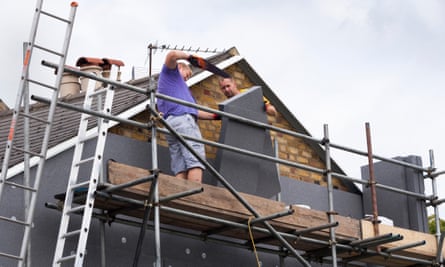 View image in fullscreenWorkers attach foam wall-insulation panels to a terraced house. Photograph: David Gee 4/Alamy
View image in fullscreenWorkers attach foam wall-insulation panels to a terraced house. Photograph: David Gee 4/Alamy
The costs can vary hugely but, courtesy of the government’s Green Homes Grant scheme, homeowners in England can apply for vouchers that in most cases will pay two-thirds of the cost of certain energy-efficient improvements, up to a maximum of £5,000 a household. Those on a low income and on certain benefits can claim the entire cost up to £10,000.
There are also other sources of help. Your energy supplier, or another company, may be able to offer assistance. For example, Nationwide offers a green additional loan that allows mortgage customers to borrow between £5,000 and £25,000 at a discounted initial interest rate, provided they spend at least half of the money on energy-efficient home improvements.
Here, with the help of the Energy Saving Trust (EST), we look at some of the most popular measures and improvements, and how much you might have to pay for them.
Insulating water tanks/pipes/radiators – a few pounds
This is a quick and easy way to save money on your bills: if you want to insulate your hot water tank, cylinder jackets can be picked up for about £10-£15 from retailers such as Screwfix and B&Q. Pipes can be insulated using foam tubes costing only a few pounds from DIY stores.
Radiator reflector foil is usually very easy to install – you put it behind your radiator and it reduces heat loss by reflecting it back into the room. Some people use kitchen foil but this week B&Q had five-metre rolls of radiator reflector foil reduced to only £1 each.
Loft insulation – up to £395, or free in some cases
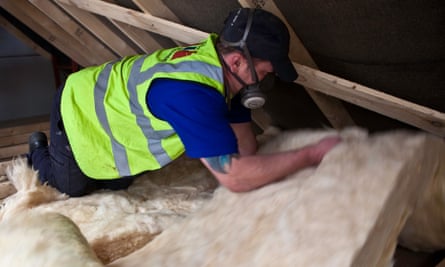 View image in fullscreenInsulation is fitted in a loft. Photograph: Andrew Aitchison/Alamy
View image in fullscreenInsulation is fitted in a loft. Photograph: Andrew Aitchison/Alamy
Loft insulation should last for decades and will hopefully pay for itself many times over.
If your loft is easy to access, you may want to do it yourself using rolls of mineral wool insulation. Some types are designed to be used as a base layer, while others are for topping up existing insulation. Basic versions can be bought from DIY stores for less than £20.
For a professional installer use the National Insulation Association’s website to find someone local. They might charge about £285 for a mid-terrace house, £300 for a semi and £375-£395 for a detached property. However, the EST says these estimates are based on installing 270mm of insulation (the recommended depth for mineral wool insulation) in a loft where there was previously none. If you are topping up existing insulation, the cost will be lower.
Some energy suppliers offer free loft insulation to eligible households under the official energy company obligation (ECO) scheme designed to help reduce carbon emissions and tackle fuel poverty. Typically, you need to be in receipt of one or more qualifying benefits. Full details can be found on the Which? website.
Cavity wall insulation – £345 to £610, or free in some cases
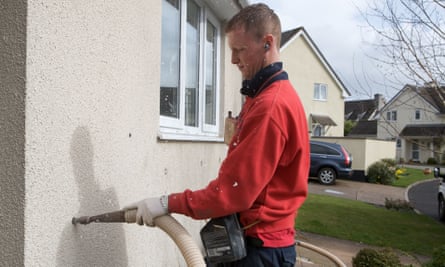 View image in fullscreenA man fills a cavity wall with insulation. Photograph: Vanessa Miles/Alamy
View image in fullscreenA man fills a cavity wall with insulation. Photograph: Vanessa Miles/Alamy
If your house was built after the 1920s, it is likely to have cavity walls. However, many homes built before the 1990s do not have any wall insulation.
Typically, you employ an installer to drill small holes in the outside walls, inject insulation material into the gap and then seal the holes with cement.
The EST puts the average cost at between £345 for a flat and £610 for a detached house with more than one floor.
Some energy suppliers offer free cavity wall insulation to eligible households under the ECO scheme (see above).
Solid wall insulation – several thousand pounds
Pre-1920 houses are more likely to have solid walls, which can be insulated either from the inside or the outside. This may take the form of insulation boards fitted to the walls.
The EST estimates the typical cost of internal wall insulation at about £7,400 and external wall insulation at about £13,000 (both figures are based on a typical semi). You might be able to reduce the bill by carrying out the work at the same time as other improvements or could opt not to do the whole house at once.
Ground floor insulation – between £520 and £1,300
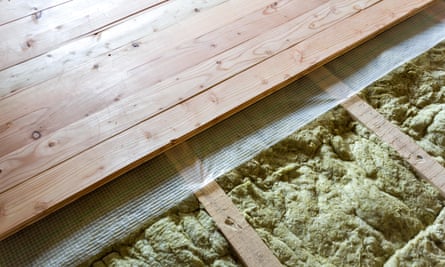 View image in fullscreenInstallation of a floor of wooden natural planks and mineral wool insulation. Photograph: Andrii Biletskyi/Alamy
View image in fullscreenInstallation of a floor of wooden natural planks and mineral wool insulation. Photograph: Andrii Biletskyi/Alamy
Newer homes tend to have concrete floors that can have rigid insulation laid on top. Older homes are most likely to have suspended timber floors, which can be insulated by lifting the floorboards and laying mineral wool insulation between the joists.
The EST estimates that a typical installation by a professional will cost between £520 and £1,300. However, the cost can vary significantly depending on the size of the house.
Installing insulation under floorboards on the ground floor will typically save about £40 a year on heating bills. However, there are also cheap, quick fixes such as blocking gaps in the floor and skirting boards with a tube of sealant from a DIY store, or putting down rugs and carpets.
Solar photovoltaic panels – £4,800 (average cost, including VAT)
Solar PV panels convert energy from the sun into electricity. “They are an effective measure that will cut electricity bills and your carbon footprint,” the EST says. There are lots of options, from panels that can be fitted on a sloping south-facing or flat roof to ground-standing panels or solar tiles. But check whether there are any restrictions that apply to your property.
Air source heat pumps – £9,000 to £11,000
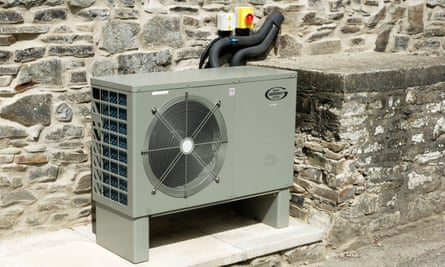 View image in fullscreenAn air source heat pump. Photograph: KBImages/Alamy
View image in fullscreenAn air source heat pump. Photograph: KBImages/Alamy
These absorb heat from the outside air to warm your home and water. Running costs will vary depending on things such as the size of your home and how well insulated it is.
Ground source heat pumps – £14,000 to £19,000
These use pipes buried in the garden to extract heat from the ground that can be used for radiators, underfloor or warm air heating systems and hot water in your home. Again, running costs will vary.


